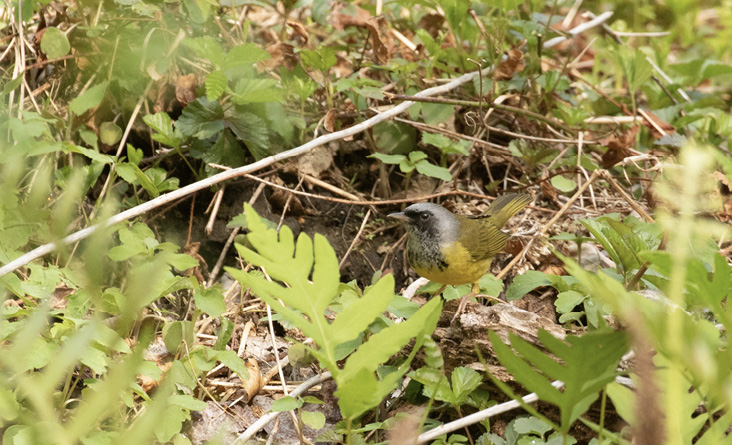Cole Winstanley

Hybrid Mourning Warbler x Common Yellowthroat. Photograph by the author.
I visited some shrubby woodlands in Leicester near the Worcester Regional Airport on May 16, 2021, looking for migrants and scarce breeders in the successional shrubland habitat. I crossed a streambed with Spiraea and tussocks of sedges and noticed a small warbler foraging silently near the ground. Immediately I thought “Mourning” by a combination of structure and the way it was using its tail. However, upon seeing the bird, it first looked like a Common Yellowthroat in plumage, with a clear black mask extending well down into the malar and auricular area, outlined with frosty gray.
Rather than the more striking features visible in the photograph, the first characteristics that I noticed were off were the bright yellow flanks and oddly large tail. Then I noticed that the black splotchy areas on the breast were not bits of mud but rather a plumage feature. These were the partial bib of a Mourning Warbler. At this point, I also noticed that the extent of the gray on the head was abnormal for a Common Yellowthroat. With the combination of the partial bib and the frosty gray on the head, I realized this was probably a Mourning x Yellowthroat and began to take photos. I didn’t get a well-lit look at the bird’s throat and breast until after I realized it was something interesting and switched to my camera.
The photos show a handful of additional marks: a whitish throat with lots of black flecks, especially on the sides, and a splotchy “bib” that might make one think of a Canada Warbler at first glance, but consists of flecks of black, whitish, and yellow. The bird had sturdy, large pink feet, bright yellow extending onto the flanks, undertail coverts, and sides of the tail, and a bright greenish olive back. Most characteristics, apart from the head, point to Mourning.
During this first encounter, I observed the bird for about 10 minutes. After losing it into some mountain laurel behind the small fen it was foraging in, I moved on. However, I passed by the spot again on my way out of the area and relocated the bird, this time getting about 45 minutes of on-and-off viewing and video recording. The bird was silent the entire time, though it did perk up and fly a few feet closer to me when I played a Mourning Warbler song.
Hybrids are somewhat more common in warblers than in other bird families; some hybrid warblers, e.g., Brewster’s Warbler, are prominently featured in many field guides. The Mourning Warbler x Common Yellowthroat hybrid is of taxonomic interest given that the genus Geothlypis—the yellowthroats—was recently expanded to include most species formerly in Oporornis, including Mourning Warbler (Escalante et al. 2009). Existence of this formerly intergeneric hybrid was an early indicator that these genera might need to be merged.
Mourning Warbler and Common Yellowthroat differ substantially in structure, size, and voice, belying their status as closely related species of the same genus. Hybrids between these two species have been recorded at least seven times, mainly on breeding grounds but with one record in Virginia away from breeding grounds. The earliest confirmed record was reported by Bledsoe (1988): a male collected in 1955 in Connecticut. Plumage features of these hybrids are variable, especially in the black bib and extent of black on the face. However, they always have a white throat, which is surprising given that neither parent species has this feature. In Massachusetts, David Sibley reported a possible sighting of this hybrid in a blog post, but otherwise I could not find any other records for the state.
References
- Bledsoe, A. H. 1988. A Hybrid Oporornis philadelphia x Geothlypis trichas, with Comments on the Taxonomic Interpretation and Evolutionary Significance of Intergeneric Hybridization. Wilson Bulletin 100 (l):1–8. https://sora.unm.edu/sites/default/files/journals/wilson/v100n01/p0001-p0008.pdf. Accessed June 1, 2021.
- Escalante P., L. Márquez-Valdelamar, P. de la Torre, J. P. Laclette, J. Klicka. 2009. Evolutionary history of a prominent North American warbler clade: the Oporornis-Geothlypis complex. Molecular Phylogenetics and Evolution 53(3):668–78. doi: 10.1016/j.ympev.2009.07.014.Accessed June 4, 2021.
- Sibley, D. 2015. An Interesting Warbler. https://www.sibleyguides.com/2015/05/an-interesting-warbler. Accessed June 1, 2021.